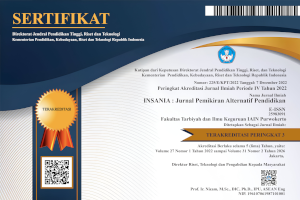Konsep Pendidikan Anak Dalam Perspektif Munif Chatib
DOI:
https://doi.org/10.24090/insania.v20i2.1434Abstract
Abstract: This study aimed to find the concept of children'a ducation in the perpective of Munif Chatib. There are several things that need to be considered by the school in the implementation of the concept of children's education. First, the input activity, which is marked by the admission of new students in a school. The school is focused on the quality of student input. The quality of the learning process depends on the quality of teachers. The teachers who are able to guarantee all students will be guided towards better change, regates all the potential inherent in student. Second, the activities of the procces that studenta diverse learning styles in the information transfer procces or a learning proccess that aims to mastery learning outcome indicators. There are four steps that must be implemented by school, namely; (1) Brain; (2) teaching strategy; (3) Product; and (4) Benefit. Third, the output (result) based on the cognitive students. Keywords: education, children, Munif Chatib.Downloads
Published
How to Cite
Issue
Section
License
Authors who publish with this journal agree to the following terms:
Authors retain copyright and grant the journal right of first publication with the work simultaneously licensed under a Creative CommonsAttribution-ShareAlike License that allows others to share the work with an acknowledgment of the work's authorship and initial publication in this journal.
Authors are able to enter into separate, additional contractual arrangements for the non-exclusive distribution of the journal's published version of the work (e.g., post it to an institutional repository or publish it in a book), with an acknowledgment of its initial publication in this journal.
Authors are permitted and encouraged to post their work online (e.g., in institutional repositories or on their website) prior to and during the submission process, as it can lead to productive exchanges, as well as earlier and greater citation of published work (See The Effect of Open Access).








